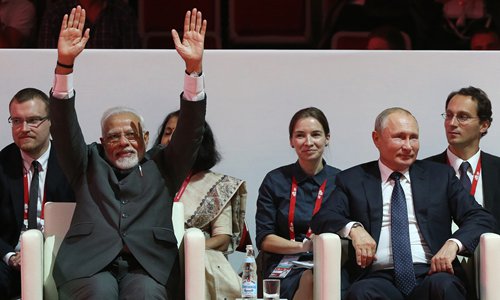HOME >> OPINION
Modi does balancing act between US and Russia
By Mao Keji Source:Global Times Published: 2019/9/20 1:03:06

Russian President Vladimir Putin (right) and Indian Prime Minister Narendra Modi (left) watch the show while visiting the Annual International Vladivostok Jigoro Junior Judo Tournament after the plenary meeting of the Eastern Economic Forum in Vladivostok, Russia, September 5, 2019. Photo: VCG
On a two-day trip in early September, Indian Prime Minister Narendra Modi visited Vladivostok to participate in the 20th India-Russia Annual Summit and attend the fifth meeting of the Eastern Economic Forum (EEF) as chief guest. Given the regularity and steadiness of Russian-Indian bilateral interactions, such a summit might well be ignored as just another ho-hum affair. However, going by the global and regional setting, something geopolitically significant is bound to emerge from Modi's latest Far East trip.
For Modi, this visit came first and foremost as a countermove to hedge New Delhi's tilt to the US. In recent years, India-US relations have been improving at an unprecedented rate. So far, India has not only signed three out of four foundational defense agreements (GSOMIA, LEMOA and COMCASA) with the US but also won from Washington the designation of "Major Defense Partner," a status commensurate with the closest allies of the US. US sale of military equipment to India also increased significantly. The purchase of Sea Guardian UAVs, multi-role helicopters (MRHs) and long-range maritime patrol P8Is were just the latest examples.
When India and the US approached each other like never, New Delhi found its cherished strategic autonomy might well be compromised. India, deeming itself a world-class power, always hates to be bound to one particular arms supplier, fearing that the over-reliance resulted from path-dependence will squeeze its strategic space. It was for this reason that India defied US pressures and sanctions threats to sign the $5.2 billion S-400 missile defense system deal with Russia. This decision tellingly demonstrated to Moscow that New Delhi remained an independent actor rather than an appendage of Washington.
New Delhi found that Russia is, more often than not, the only and the most reachable party India can resort to, especially when it comes to global geostrategic issues. For example, the US, even if sharing wariness of China with India, has been reluctant to sell the latter critical weapons like nuclear submarines or hypersonic missiles. The only country that is both capable and willing to sell these weapons remains Russia. So, in an effort to maintain the dynamic equilibrium, India always moves a step toward Russia, when it has made a similar move toward the US. It is this seesaw pattern that explained why India has ordered a "breakthrough" of $14.5 billion of Russian arms since last year, while the India-US relations made landmark progresses at the same time.
Modi's visit also functioned as a diplomatic campaign to rescue the Kashmir situation, after it unilaterally moved toward de-facto annexation of the region that it was controlling. Major Western governments and media outlets remain skeptical of Modi's moves to consolidate control over Kashmir. The US approached the Kashmir issue with a balancing stance and even offered to mediate between India and Pakistan.
While Moscow understood the strategic dangers of New Delhi's pro-US pivot in recent years and the need to balance regional affairs by strengthening the Russia-Pakistan ties in response, it, at the end of the day, stood by India on the Kashmir issue. Russian Ambassador to India Nikolay Kudashev said that "India's decision on Jammu and Kashmir is a sovereign decision which is as per its Constitution," during a press conference in late August.
While Moscow surrendered its credibility as a neutral actor in the region, the US retained its strategic flexibility and replaced Russia's lost role. For sure, Russian solidarity with India did not come without a cost. Stung by Western sanctions and liberal attacks, Moscow aimed not only to maintain its ultra-profitable weapons relationship with India, but also to harvest even more benefits, be it economic or strategic. It was in this context that Modi brought with him a large contingent of Indian entrepreneurs, and signed with Putin a number of high-profile memorandum of understandings, including developing a maritime corridor from Vladivostok to Chennai, a deal for India to manufacture spare parts for Russian military equipment, an agreement by Indian companies to purchase Russian LNG etc.
Exploiting Moscow's concern of overdependence on China, India also marketed its presence in Russia as a balancing factor. For example, India has been keen on selling the idea of "Indo-Pacific" to Russia by encouraging Moscow to re-emerge as a Pacific power in its own right rather than as a junior partner of China. While New Delhi rejects the Western concept of "containment" against China, it surely desires to take up the mantle of the Indo-Pacific agenda by making a Russian buy-in feasible.
The author is an associate researcher at the International Cooperation Center of the National Development and Reform Commission. opinion@globaltimes.com.cn
Posted in: ASIAN REVIEW